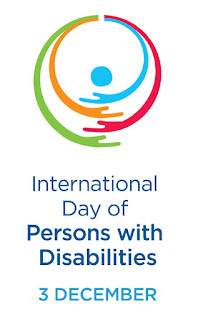- Leave tooltips and other mouse-triggered pop-ups visible while the mouse is on the displayed content.
- Don't obscure content when the mouse is hovering over it.
- Put the result of an action close to the place where the action was triggered.
Todo tipo de información sobre accesibilidad en la Web: errores de accesibilidad, ejemplos de páginas inaccesibles, noticias, software, hardware, ayudas técnicas, tecnologías de apoyo, consejos, pautas y guías de accesibilidad, WAI, WCAG, Norma UNE 139803:2004, legislación, etc.
Buscador
viernes, 8 de diciembre de 2017
Cómo hacer más accesible un sitio web a las personas que usan un magnificador de pantalla
En How to Make Your Website Accessible to People Who Use a Screen Magnifier se dan algunos consejos para que un sitio web sea más accesible para las personas que usan un magnificador de pantalla:
miércoles, 6 de diciembre de 2017
domingo, 3 de diciembre de 2017
Día Internacional de las Personas con Discapacidad
El Día Internacional de las Personas con Discapacidad se observa en todo el mundo cada 3 de diciembre de acuerdo a la resolución 47/3 de la Asamblea General adoptada el 14 de octubre de 1992, con el objetivo de llamar la atención y movilizar apoyos para aspectos clave relativos a la inclusión de personas con discapacidad en la sociedad y en el desarrollo.
Más información en International Day of Persons with Disabilities 3 December.
Más información en International Day of Persons with Disabilities 3 December.
viernes, 1 de diciembre de 2017
La guía definitiva de los textos alternativos
El artículo Alt-texts: The Ultimate Guide posee numerosos ejemplos que ayudan a entender el correcto uso del texto alternativo.
También proporciona algunos consejos para crear el texto alternativo perfecto:
También proporciona algunos consejos para crear el texto alternativo perfecto:
- Describe the image.
- El texto alternativo depende del contexto.
- Mantenlo conciso.
- No digas que es una imagen.
- Finaliza con un punto.
- No uses el atributo title.
miércoles, 29 de noviembre de 2017
lunes, 27 de noviembre de 2017
SortSite - Accessibility Checker and Validator
SortSite es una herramienta automática de evaluación de la accesibilidad web. Es una herramienta de pago que permite un uso gratuito limitado.
La forma de presentar los resultados del análisis es muy interesante:
La forma de presentar los resultados del análisis es muy interesante:
viernes, 24 de noviembre de 2017
Diseño universal, diseño inclusivo, diseño accesible, diseño para todos
Interesante el artículo Universal design, inclusive design, accessible design, design for all: different concepts—one goal? On the concept of accessibility—historical, methodological and philosophical aspects:
Accessibility and equal opportunities for all in the digital age have become increasingly important over the last decade. In one form or another, the concept of accessibility is being considered to a greater or smaller extent in most projects that develop interactive systems. However, the concept varies among different professions, cultures and interest groups. Design for all, universal access and inclusive design are all different names of approaches that largely focus on increasing the accessibility of the interactive system for the widest possible range of use. But, in what way do all these concepts differ and what is the underlying philosophy in all of these concepts? This paper aims at investigating the various concepts used for accessibility, its methodological and historical development and some philosophical aspects of the concept. It can be concluded that there is little or no consensus regarding the definition and use of the concept, and consequently, there is a risk of bringing less accessibility to the target audience. Particularly in international standardization the lack of consensus is striking. Based on this discussion, the authors argue for a much more thorough definition of the concept and discuss what effects it may have on measurability, conformance with standards and the overall usability for the widest possible range of target users.
miércoles, 22 de noviembre de 2017
Suscribirse a:
Entradas (Atom)

